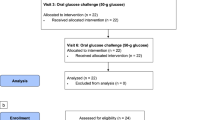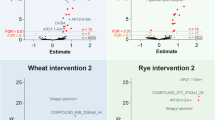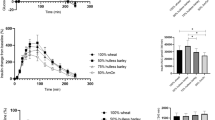Abstract
Objective: To analyse the lignan content of phloem powder enriched rye bread and to study the dose–response relationship of the effect of dietary plant lignans derived from phloem on intestinal production of enterolactone by measuring enterolactone concentration in serum.
Design: A randomized double-blind supplementation trial.
Subjects: Seventy-five non-smoking men recruited by newspaper advertisements.
Intervention: Subjects were randomized to three study groups receiving either rye bread high in phloem (HP, 14% of rye flour substituted with phloem powder), rye bread low in phloem (LP, 7% of rye flour substituted with phloem powder) or placebo rye bread. Participants consumed 70 g of study bread daily for 4 weeks and provided serum samples for enterolactone analysis at baseline and at the end of the intervention.
Results: There was a significant increase in serum enterolactone concentration in the LP and HP groups compared with the placebo group (P=0.009 and P=0.003, respectively). Considerable interindividual differences were observed in the response to dietary lignans within the study groups.
Conclusions: Our results indicate that plant lignans attached to insoluble fibre layer in phloem can be further metabolized and converted to enterolactone presumably by the bacteria present in the colon. Phloem powder is useful source of lignans for functional foods aimed to elevate serum enterolactone levels.
Sponsorship: Phloem powder and the study breads were provided by Finnpettu Oy and Linkosuo Oy, respectively. The clinical study work was sponsored in part by Oy Jurilab Ltd.
This is a preview of subscription content, access via your institution
Access options
Subscribe to this journal
Receive 12 print issues and online access
$259.00 per year
only $21.58 per issue
Buy this article
- Purchase on Springer Link
- Instant access to full article PDF
Prices may be subject to local taxes which are calculated during checkout




Similar content being viewed by others
References
Adlercreutz H, Mazur W . 1997 Phyto-oestrogens and Western diseases Ann. Med. 29: 95–120
Adlercreutz H, Wang G-J, Lapcik O, Hampl R, Wähälä K, Mäkelä T, Lusa K, Talme M, Mikola H . 1998 Time-resolved fluoroimmunoassay for plasma enterolactone Anal. Biochem. 265: 208–215
Anderson JW, Hanna TJ . 1999 Whole grains and protection against coronary heart disease: what are the active components and mechanisms? Am. J. Clin. Nutr. 70: 307–308
Ayres DC, Loike JD . 1990 Isolation, purification and initial characterisation In: Lignans Chemical, Biological and Clinical Properties Cambridge: Cambridge University Press
Heinonen S, Nurmi T, Liukkonen K, Poutanen K, Wähälä K, Deyama T, Nishibe S, Adlercreutz H . 2001 In vitro metabolism of plant lignans: new precursors of mammalian lignans enterolactone and enterodiol J. Agric. Food Chem. 49: 3178–3186
Hertog MG, Feskens EJ, Hollman PC, Katan MB, Kromhout D . 1993 Dietary antioxidant flavonoids and risk of coronary heart disease: the Zutphen Elderly Study Lancet 342: 1007–1011
Hutchins AM, Lampe JW, Martini MC, Campbell DR, Slavin JL . 1995 Vegetables, fruits, and legumes: effect on urinary isoflavonoid phytoestrogen and lignan excretion J. Am. Diet. Assoc. 95: 769–774
Juntunen KS, Mazur WM, Liukkonen KH, Uehara M, Poutanen KS, Adlercreutz HC, Mykkanen HM . 2000 Consumption of wholemeal rye bread increases serum concentrations and urinary excretion of enterolactone compared with consumption of white wheat bread in healthy Finnish men and women Br. J. Nutr. 84: 839–846
Kilkkinen A, Stumpf K, Pietinen P, Valsta LM, Tapanainen H, Adlercreutz H . 2001 Determinants of serum enterolactone concentration Am. J. Clin. Nutr. 73: 1094–1100
Knekt P, Jarvinen R, Reunanen A, Maatela J . 1996 Flavonoid intake and coronary mortality in Finland: a cohort study Br. Med. J. 312: 478–481
Mazur W, Fotsis T, Wähälä K, Ojala S, Salakka A, Adlercreutz H . 1996 Isotope dilution gas chromatographic–mass spectrometric method for the determination of isoflavonoids, coumesterol, and lignans in food samples Anal. Biochem. 233: 169–180
Morton MS, Wilcox G, Wahlqvist ML, Griffiths K . 1994 Determination of lignans and isoflavonoids in human female plasma following dietary supplementation J. Endocrinol. 142: 251–259
Morton MS, Matos-Ferreira A, Abranches-Monteiro L, Correia R, Blacklock N, Chan PS, Cheng C, Lloyd S, Chieh-ping W, Griffiths K . 1997 Measurement and metabolism of isoflavonoids and lignans in the human male Cancer Lett. 114: 145–151
National Public Health Institute. 1998 The 1997 Dietary Survey of Finnish Adults Publications of the National Public Health Institute no. B 8/1998 Helsinki: Hakapaino Oy
Ness AR, Powles JW . 1997 Fruit and vegetables, and cardiovascular disease: a review Int. J. Epidemiol. 26: 1–13
Rosling H . 1993 Cyanide exposure from linseed Lancet 341: 177
Stumpf K, Uehara M, Nurmi T, Adlercreutz H . 2000 Changes in time-resolved fluoroimmunoassay of plasma enterolactone Anal. Biochem. 284: 153–157
Vanharanta M, Voutilainen S, Lakka TA, van der Lee M, Adlercreutz H, Salonen JT . 1999 Risk of acute coronary events according to serum concentrations of enterolactone: a prospective population-based case-control study Lancet 354: 2112–2115
Acknowledgements
We thank Adile Samaletdin and Kristiina Nyyssönen for supervising the chemical analyses, Katri Juntunen for help with literature and the personnel of Oy Jurilab Ltd (www.jurilab.com) and of Research Institute of Public Health, University of Kuopio, Finland.
Author information
Authors and Affiliations
Corresponding author
Rights and permissions
About this article
Cite this article
Vanharanta, M., Mursu, J., Nurmi, T. et al. Phloem fortification in rye bread elevates serum enterolactone level. Eur J Clin Nutr 56, 952–957 (2002). https://doi.org/10.1038/sj.ejcn.1601510
Received:
Accepted:
Published:
Issue Date:
DOI: https://doi.org/10.1038/sj.ejcn.1601510
Keywords
This article is cited by
-
Serum enterolactone concentrations are low in colon but not in rectal cancer patients
Scientific Reports (2019)
-
Plasma enterolactone and risk of colon and rectal cancer in a case–cohort study of Danish men and women
Cancer Causes & Control (2010)



